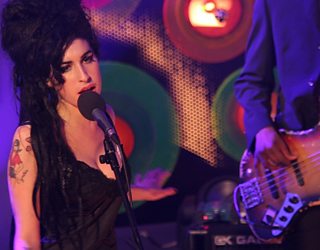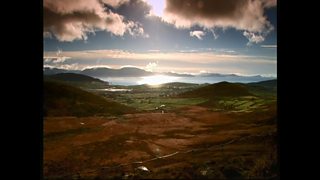Asif Kapadia's 'Amy' and 'The Day She Came to Dingle'
In December 2006, Amy Winehouse performed for , an acclaimed Irish TV series filmed in Dingle every winter. For the 2012 programme ‘Amy Winehouse: The Day She Came to Dingle’, Arena joined forces with Other Voices and caught up with some of the people that Amy met on that day, including taxi driver Paddy Kennedy, her bass player Dale Davis and Rev Máirt Hanley of the Other Voices church. In this blog post, we take a look at the connections between Asif Kapadia’s award-winning film ‘Amy’, released on DVD today, and ‘…The Day She Came to Dingle’.

Asif Kapadia’s ‘Amy’ is a picture of living hell. A hell where one is never allowed a moment’s peace from the intrusive lens of the paparazzi camera, a lens that follows Winehouse on holiday, to GP appointments, and even to her death, as we see footage of her body carried out of her house in a red body bag. Hell is London’s Camden Town, a place where vices abound and privacy has been defeated.
Amidst all her emotional and physical troubles, it is easy to forget about Amy Winehouse as a musician – not only did she possess a formidable talent but as her pianist Sam Beste notes in ‘Amy’, ‘she had one of the most pure relationships with music - like it was a person’. This acute observation echoes a comment Winehouse makes in an interview with John Kelly for Other Voices, as she explains how she responds to the religious sentiment in gospel music.
‘I’m not religious, but there’s nothing more pure than the relationship you have with God or what you believe in – apart from your love of music.’
This interview is featured in ‘Amy Winehouse: The Day she came to Dingle’, a film which captured a moment where Winehouse found the kind of paradise she constantly pursued but rarely found, a sanctuary in which her relationship with music was allowed to flourish.
Every winter, Other Voices plays host to one of the most exclusive music festivals in the world, in Dingle, a remote town in County Kerry on the Atlantic coast. In medieval times, the Irish residents thought it was ‘the edge of the known world’, and it was believed that if you ventured out into the sea, you might fall off the face of the earth. As Philip King, editor of Other Voices notes, getting there ‘takes a commitment’.

Winehouse played St. James’ Church, an intimate 80-seat space that has seen performances from artists as varied as Ryan Adams and Florence + the Machine.
‘It does feel nearly like an act of praise or an act of worship to have [these musicians] perform in this space’ explains the Rev. Máirt Hanley.
The perfect stage is set for Amy Winehouse, whose act is one of praise and worship for the idol that is music. The production is pared down, and the atmosphere is ‘communal and collegiate’, with a distinct absence of ‘clipboards running around’, as Other Voices music producer Aoife Woodlock puts it. It is a long way from the perilous glitz and glamour of the BRIT Awards that came just months later, and the baying mobs of Amy’s final, catastrophic concert in Belgrade, powerfully portrayed in Asif Kapadia’s film.
‘She said it was her dream to play in small venues,’ recalls Sam Beste, in ‘Amy’.
It is a wet and windy December night in 2006 when Winehouse performs. Her rebellious demeanour contrasts with her meek mannerisms in between songs, as she repeatedly thanks her audience with the grace of a shy ballerina. She catches you by surprise every time she begins a song, such is the ease and spontaneity with which her voice soars.
‘When Amy sang, she let us in – if we have the ears to hear, and the eyes to see – into the heart of who she was as a singer,’ King remembers.
‘When she was here, I felt she was happy . . . She sang the blues away . . . She used her gift to still her trembling soul. She used her gift as a way to explain herself to herself . . . to give herself some relief’.
After the performance comes the interview with John Kelly, an interview in which she discusses her musical influences. Her eclectic taste and profound musical erudition are evident, and she is unafraid to express strong opinions, admitting that Ella Fitzgerald ‘doesn’t stand out’ to her as a performer, preferring instead the likes of Sarah Vaughan. As in the performance, what is striking about this interview is that this is a woman who is simply allowed to enjoy her relationship with music, the kind of luxury that would prove increasingly difficult in the hellish years that followed.
Watching ‘Amy’, we learn that Winehouse lived by the mantra that ‘Life is short’ – . This remains a source of immense regret for the rest of us. Too often we are told ‘that art comes out of a sense of things not being right . . . struggle or suffering or people being really extreme’ begins the Rev. Máirt Hanley, adding that in Amy’s case, it ‘came out, to an extent, of her living life on the edge.’
‘But it doesn’t have to stay on the edge . . . And her music is tinged with the sadness that she never got that resolution. It’s so very tragic.’ This statement prefigures sentiments expressed by Tony Bennett in ‘Amy’:
‘Life teaches you how to live if you can live long enough.’
Hiro Mikuriya has written this post for Arena. He is a London-based student who did work experience with Arena in the summer of 2015. He is currently completing an English MA in Issues in Modern Culture at University College London, having recently completed his BA in English Literature at the same university.